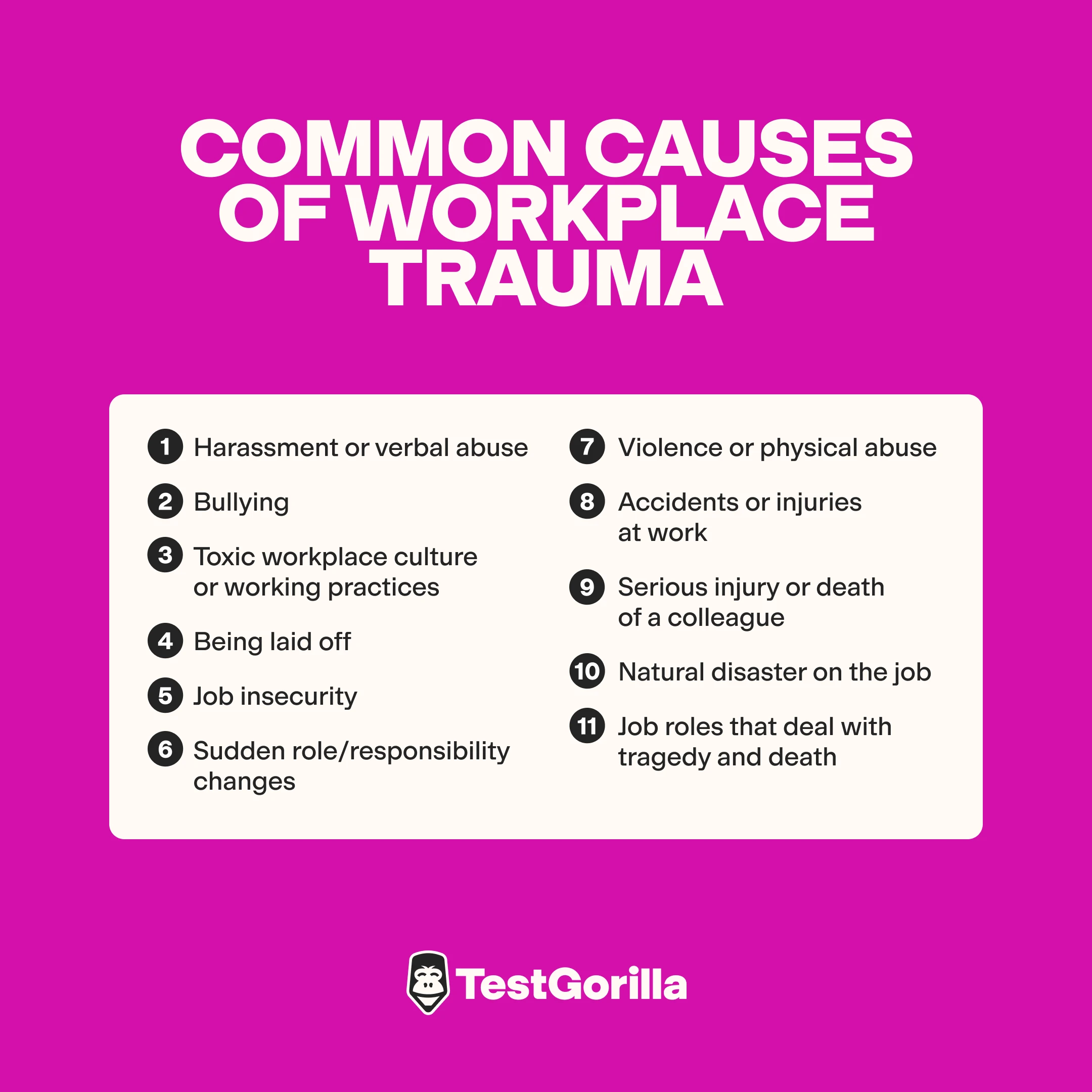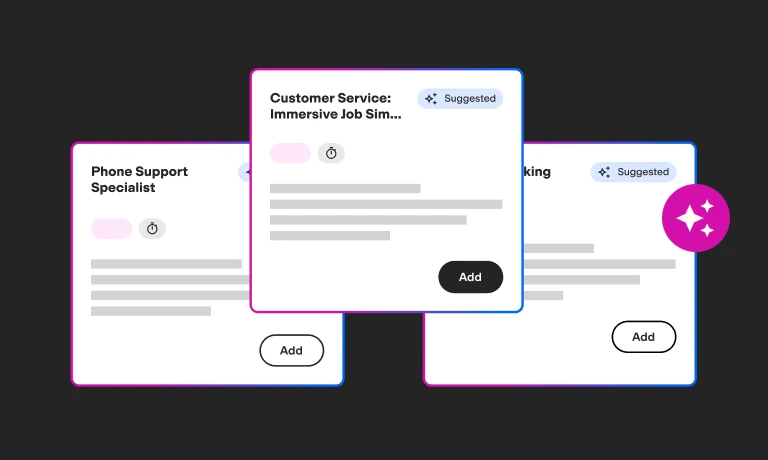When we picture trauma, we think of earth-shattering events or life-changing accidents. But what about the things that happen at work? The toxic boss who chips away at your confidence, the impossible workload that leaves you burned out, or the time you were unfairly treated and just had to “get on with it”?
Workplace trauma exists in every occupation, and it sticks with you long after you’ve logged off. It can cause extreme anxiety, depression, and employee burnout, leading to absenteeism, conflict, and reduced productivity.
Keen to avoid this in your workplace and support psychological safety? This article discusses the leading causes and signs of workplace post-traumatic stress disorder (PTSD) and the eight best practices your company can implement to support sufferers of traumatic experiences in the workplace.
What is workplace trauma?
Workplace trauma, also called career trauma or workplace PTSD, is an emotional response to negative events at work. This can include accidents, natural disasters, and exposure to a toxic work environment.
Workplace trauma is usually the result of an overwhelming workplace experience. This may be an acute, one-off event, like being unfairly fired, or an ongoing stressful event, like dealing with workplace bullying. However, in many cases, the workplace event could be the final straw rather than the sole cause of the stress. Remember, everyone handles situations differently, and everyone can handle different levels of stress before it takes its toll.
Many factors come into play when handling stress, such as a person’s emotional resilience, control over the situation, and outside support during a stressful time. You may have come across the concept of a “stress bucket,” coined by the Cancer Psychology Service and adopted by many reputable mental health charities, like Mental Health UK.
Your stress bucket is a metaphorical bucket that slowly fills up as you experience different types of stress. If you have more stress in your personal life than your colleagues, have a history of trauma, or simply have fewer outlets for stress, you may find there’s less space in your stress bucket for workplace challenges before it starts to overflow. When that happens, even minor workplace stressors can feel overwhelming, and coping in ways that usually work for you might become harder.
The important thing when it comes to stress management isn’t to try to increase the size of your bucket but to find ways to empty it regularly. That might mean setting boundaries at work, making time for activities that help you unwind, or reaching out for support when needed. Everyone’s bucket fills up differently, so what works for one person might not work for another. The key is to recognize when it’s getting too full and take steps to let some of that stress out before it overflows.
You may also like: For more information on what can cause an event to become traumatic, read our article on how to create a trauma-informed workplace.
Workplace PTSD isn’t currently defined in the DSM-5 (The Diagnostic and Statistical Manual of Mental Disorders), but lately, it’s been gaining the attention it deserves.
Dr. Chi-Chi Obuaya, a psychiatrist and mental health professional, says he’s hesitant to relate workplace trauma directly to clinically defined PTSD. However, the disorder causes real damage and may be closer to severe anxiety or depression.
The causes of workplace trauma
Although many events and situations can contribute to workplace trauma, here are the most common causes:
Harassment or verbal abuse: Being yelled at, demeaned, or patronized (especially in front of others).
Bullying: Others abusing power to intimidate, degrade, humiliate, or threaten.
Toxic workplace culture or working practices: Being encouraged to work constantly, engaging in “hustle culture,” and being pressured into not taking time off.
Being laid off: Losing your job, especially when it was no fault of your own and simply the result of a company restructuring.
Job insecurity: Thinking you could lose your job, which can come from layoffs happening around you, fearing your role becomes obsolete, or feeling inadequate.
Sudden role/responsibility changes: Feeling insecure, uncertain, or panicked after sudden changes to your activities and responsibilities.
Violence or physical abuse: Physical harm, property damage, or even sexual abuse.
Accidents or injuries at work: Hazardous conditions such as poor working environments or on-the-job risks (e.g., construction or factory accidents).
Serious injury or death of a colleague: Witnessing or being involved in a colleague’s accident, injury, or death.
Natural disaster on the job: Experiencing a fire, earthquake, or hurricane during work.
Job roles that deal with tragedy and death: Working closely with death, tragedy, and accidents in frontline roles – such as doctors, nurses, EMTs, rescue workers, and other first responders.
As an example, let’s examine workplace bullying.
Did you know that up to 30% of US adults have experienced some type of workplace bullying? That’s a staggering number, and it shows just how common this issue really is.
Workplace bullying poses a considerable risk to the mental health and psychological safety of your workforce. Aside from causing mental distress, it can have a real physical impact on your employees. For example, victims of workplace bullying are more likely to experience headaches, acute pain, chronic neck problems, and cardiovascular disease.
Further to this, bullying can cause an increase in staff turnover, decreased productivity, and increased absenteeism. These are all signs and symptoms of workplace trauma, clearly highlighting its link with bullying.
If that wasn’t enough, if your organization repeatedly fails to deal with bullying behavior, you may find yourself on the wrong end of a legal battle. Neglecting to address workplace bullying can lead to lawsuits, reputational damage, and a loss of trust from employees. What’s more, this kind of inaction sends a message that bullying is tolerated, which can seriously undermine your company culture.
The best insights on HR and recruitment, delivered to your inbox.
Biweekly updates. No spam. Unsubscribe any time.
The signs of workplace trauma
Career trauma has many symptoms and signs similar to PTSD, anxiety, and depression.
It also affects your workers in many of the same ways, including absenteeism, lower performance, and conflict with teammates.
Let’s take a look at the main signs of emotional trauma in the workplace:
Symptom | Description |
Absenteeism | Workplace trauma can cause workers to miss work because of stress, anxiety, or even active avoidance. |
Limited ability to build relationships or work in a team | Building relationships and team cooperation can be especially difficult for those hurt by work-related issues. |
Anxiety | Workplace PTSD can cause intrusive thoughts, jitters, nervousness, low concentration, and physical anxiety symptoms such as nausea, fatigue, and hyperventilation. |
Insomnia | Employees may struggle to sleep, leading to emotional instability, paranoia, fear, and memory loss. |
Burnout | People with workplace PTSD are much more prone to exhaustion, stress, and apathy. |
Panic attacks | Workplace trauma can cause sudden attacks of intense fear that can include shortness of breath, chest pains, and loss of control. |
Depression | A loss of meaning, motivation, or joy, as well as emotional numbness to life, is another possible consequence of trauma at the workplace. |
Feeling undervalued and lost | Workers may feel a loss of confidence, little to no workplace respect, and worthlessness. |
Unexplained bursts of anger or aggression | Workplace trauma can lead to bouts of irritability and anger, seemingly without reason. |
Withdrawal and reduced productivity | Workers may feel detached from their roles, responsibilities, and colleagues, affecting their performance and the quality of their work. |
The signs and symptoms of workplace trauma affect the worker and, subsequently, the company they work for.
Supporting employees through the trauma they experience helps increase productivity, quality of work, and overall satisfaction and retention.
And, above all, it’s just the right thing to do.
How leaders can mitigate the effects of workplace trauma and support their employees
The best thing you can do for your employees is to build a positive, supportive company culture and cultivate a work environment that people want to be in.
Implementing these practices helps prevent situations that could traumatize your workers in the future. Although completely recovering from workplace trauma may be difficult or impossible for some, you can create a better, healthier atmosphere for them.
Here are our top strategies for leaders:
Best practice | Description |
Build a collaborative and trusting culture | Nurture a “safe space” atmosphere where employees feel they can speak openly. |
Ask your employees what they need | Be proactive and ask your workers about their struggles and needs. |
Reduce stigma around workplace trauma | Work to normalize speaking about workplace trauma and treat it as a serious topic. |
Offer long-term professional support to your employees | Offer employee benefits like counseling, therapy, support groups, and other mental health resources. |
Help employees recover from a traumatic event with a flexible work schedule | Enable employees to get their work done when and where it’s best for them. |
Invest in employee resiliency training to help your people develop better coping skills | Bolster your workers’ resiliency and help vulnerable employees build the right skills. |
Provide outplacement services to employees you lay off to reduce the trauma they face | Support employees who have been laid off by supplying outplacement services. |
Use Critical Incident Stress Debriefing (CISD) following a traumatic event | Arrange for healthy trauma treatment for affected employees. |
As we discuss these best practices and others, it’s important to remember that you can’t guarantee a trauma-free workplace. While you can take steps to minimize risks through trauma-informed leadership, sometimes traumatic experiences are simply unavoidable.
As a trauma-informed leader, it’s your job to take action and:
Prepare employees for possible trauma
Support employees in case of trauma
Stop any preventable form of trauma as soon as possible (i.e., abuse from a manager)
For more advice on tackling issues like toxic negativity, read our article on empathy in the workplace.
But for now, let’s take a look at the top strategies for supporting workplace trauma.
1. Ensure you have the right policies in place
The first step in tackling workplace trauma is to have clear, well-informed policies to stamp out unacceptable behavior and help your employees feel in control. Your team needs to feel confident that there’s a safe and transparent process for reporting any issues they face, whether that’s bullying, harassment, or other harmful behavior.
Your policies should not only define what constitutes inappropriate conduct but also outline the support available to employees, ensuring they know what resources are at their disposal.
As a minimum, you should have:
An anti-bullying and harassment policy
A whistleblowing policy
A grievance policy
A support and well-being policy
Having these policies in place shows you take allegations of poor behavior and bullying seriously and are prepared to stamp them out.
However, you can’t set it and forget it. Simply having these policies isn’t enough. You need to communicate their use to your employees, regularly amend them in line with legislative updates, and ensure managers and team leaders are trained to handle sensitive issues effectively. You should offer regular training, send out periodic reminders when updates are actioned, and ensure they’re stored in an easy-to-access place for all staff members.
2. Build a collaborative and trusting culture
The top reason that employees suffer in silence is that they don’t feel safe enough to speak up.
They may fear being judged, harassed, or not taken seriously and even losing their jobs. So, instead of facing that possibility, they keep their trauma to themselves.
You can combat this by nurturing a positive, supportive culture.
Build a culture where employees aren’t afraid to speak to managers and HR about their issues – a “safe space” where workers feel comfortable discussing their bad days, struggles, stressors, and triggers.
Here are a few ways to start creating a more trusting culture:
Be patient and respectful: Treat your employees with courtesy, listen to their ideas, and approach workplace conflict in a healthy, nonviolent way.
Show your employees you care: Be proactive in asking workers about their needs and issues (more on that in the section below).
Handle problems delicately: If an employee opens up to you, nurture this trust by handling the issue with dignity, care, and seriousness.
Eliminate toxic behaviors that trigger trauma: Cull toxic behaviors like yelling and bullying to make employee trust easier to build.
Share your own issues and lead by example: Help employees think of work as a safe space to share their feelings by showing that leaders are doing it, too.
Take small steps and, above all, be patient. It may take some time for an employee with workplace trauma to build enough trust to consider work a safe space to open up.
3. Ask your employees what they need
Employees may be unwilling to disclose their struggles and ask for accommodations. They could feel like a burden and fear that they might lose their favorable position.
What’s the solution when workers don’t openly share their issues? Ask them proactively.
Many employees open up immediately if senior leadership makes the first move and asks to support them.
Try incorporating mental health discussions during one-on-one meetings. Set aside a few minutes to ask your employees about their struggles. Ask questions like:
“Do you need support right now?”
“Can I refer you to an employee resource group/therapist?”
“What can the company do to help you?”
“I’m here if you want to talk.”
The last one is simple but effective.
We also recommend that these one-on-ones be frequent, about every one to two weeks. This enables you to catch problems before they snowball into larger issues.
4. Reduce stigma around workplace trauma
You can help your employees who struggle with workplace PTSD simply by striving to reduce the stigma surrounding it.
Unfortunately, workplace trauma is largely a joke in the working world.
You’ve probably heard a water cooler joke that sounds something like, “My last job was so bad it scarred me!”
It’s time to normalize serious talk about workplace trauma and educate people that it isn’t just a joke. Taking this problem seriously is a big step in the right direction.
Here are a few ways you can treat workplace trauma with the care it deserves:
Destigmatize mental health issues in general: A company that’s open about mental health and trauma opens the door for a culture that supports team members who suffer from workplace PTSD.
Organize trauma-supporting events: Get qualified external speakers to talk about trauma, its impact, and how to overcome it.
Have leaders speak about personal experiences: Use personal stories and struggles to relay to your employees that workplace trauma is real.
Educate on the difference: Many employees dismiss workplace trauma as simple “stress,” so educating them on the difference is important.
Keep an eye out for toxic individuals: The biggest way stigmatizing attitudes and language spread is through individuals. Keep an eye out for these people and communicate with them the seriousness of the situation.
Overcoming stigmas around workplace trauma and normalizing healthy conversations, help affected individuals be more willing to share their struggles and seek support.
Once they feel comfortable enough to start opening up, you can help them recover and work on their overall well-being.
5. Offer long-term professional support to your employees
Your employees may need more than just a positive conversation and a shoulder to lean on. In these cases, professional support in the form of therapy and counseling can be a lifesaver.
Usually falling under the umbrella of Employee Assistance Programs (EAP), they include mental health support, counseling services, and workplace trauma support and are usually extended to the employee and their family.
Try incorporating more mental health and wellness programs into your company's healthcare benefits. These can include:
Digital therapeutics
In-person therapeutics
Personal coaching
Employee resource groups
A healthcare plan that covers the treatment of anxiety, depression, and other psychiatric illnesses
Counseling and therapy can be invaluable to a struggling employee. However, due to mental health stigma, financial concerns, or a lack of support from family, they may never seek professional help on their own.
6. Help employees recover from a traumatic event with a flexible work schedule
When recovering from workplace trauma, sometimes the last thing a person needs is a tight, unforgiving schedule.
If the traumatic event happened recently, start by giving the affected employee ample time off to begin the difficult process of recovery.
It’s also important to give employees the option of alternative working arrangements. Implement a flexible work policy and suggest flexible schedules to those in need.
This could include:
Remote work
Hybrid offices
Flexibility in terms of location and schedule is a huge relief to a person recovering from mental health problems. This enables them to work whenever and wherever they feel the most productive and energetic instead of relying on rigid times and locations.
This could be particularly useful if sights and sounds in their workplace trigger the individual. Working from their home office or a cafe could benefit their concentration and recovery.
However, when employees with workplace trauma work remotely or during off-hours, it’s crucial to maintain regular communication through chat programs like Slack and have frequent one-on-one meetings.
These people are in a fragile mental state, and taking steps to prevent work-from-home depression is critical.
7. Invest in employee resiliency training to help your people develop stronger coping skills
An effective way to mitigate potential workplace trauma is to identify those at greatest risk and help them build the right skills.
Helping vulnerable workers develop coping skills prevents future trauma, especially in intense job roles like doctors, rescue workers, and nurses.
Identify these at-risk individuals using online skills testing to discover their emotional stability.
Tests like the Big 5 (OCEAN) test help you assess your employees’ resiliency in the face of pain and trauma. If the results show the worker is likely to struggle with workplace trauma, you can take steps to help them boost their resiliency and coping mechanisms.
Another way skills testing can facilitate a trauma-informed workplace is through the hiring process.
For example, a Culture Add test enables you to hire candidates that align with your values, beliefs, and culture. This minimizes the chance of hiring a toxic individual who contributes to workplace trauma.
Assessing employee personalities helps you shape your workforce to be as inclusive and healthy as possible.
8. Provide outplacement services to employees you lay off to reduce the trauma they face
Layoffs are one of the top causes of workplace trauma.
Losing your job can be painful. You’re losing a source of income, a lifestyle, a routine, and many colleagues.
It can be even more difficult to lose your job during organizational restructuring, as the layoff typically has nothing to do with the employee’s skill or attitude – their role simply isn’t needed anymore.
Ease this transition and mitigate possible trauma by providing outplacement services to displaced individuals. This can include providing career assessments, writing them a recommendation on LinkedIn, offering networking help, and helping them prepare for future interviews.
You can offer these services alongside the severance package in your separation agreement. You can even go the extra mile by working with placement providers for professional assistance.
Outplacement services can help prevent an employee from suffering workplace trauma due to the security and opportunities they provide.
However, the emotional aspect is perhaps more important: By offering employees aid and care in a moment of need, you step in and prevent potential long-lasting trauma from a perceived lack of support.
For more information on handling layoffs delicately, read our full guide on how to lay off employees.
9. Use Critical Incident Stress Debriefing (CISD) following a traumatic event
Critical Incident Stress Debriefing is a group process conducted soon after a traumatic event to mitigate and ease the symptoms of trauma. It’s usually led by a trained mental health professional.
This type of support involves encouraging the affected workers to talk about their experience and how it impacted them, as well as providing them with therapy and professional support.
Critical Incident Stress Debriefing is an early intervention process to provide group support while the pain is still fresh. It usually concludes by offering additional help, counseling, and therapy as needed.
A 2020 study showed that playing Tetris soon after a traumatic event helped the symptoms. This is due to the way the human brain holds onto traumatic memories.
This process works because a memory must be consolidated into long-term memory for the brain to be able to access it easily later. In the early stages, memory is highly susceptible to interference.
This study suggested that any demanding task that takes up the brain’s cognitive resources helps weaken the traumatic memory trace. Other sensory-intensive activities, such as playing games and making art, also work.
Critical Incident Stress Debriefing can be an invaluable process to integrate into your business policies in the event of a traumatic event.
10. Perform stress risk assessments
Stress risk assessments are an essential part of identifying key stressors in the workplace before they become a problem.
In the same way you’d action a risk assessment for a pregnant employee or welcoming a colleague learning to live with a disability back to the workforce, stress risk assessments help you spot potential issues that could impact your team's mental health and well-being before they begin to fester.
This means looking at factors like workload, deadlines, job role clarity, work-life balance, and workplace culture. You can take preventative action by identifying where stress might be building up. This could mean adjusting workloads, offering support, or creating a more inclusive work environment.
All these steps can reduce workplace stress, ensuring your team’s stress bucket fills up more slowly and ultimately helping them manage workplace pressure better.
Create a safer environment to reduce the risk of workplace trauma and support those who suffer from it
Workplace trauma is no longer a sitcom joke. You can take steps to treat it with the respect it deserves.
Building a safe culture, watching for toxic behaviors, and offering support and professional help are effective ways to counter this dangerous workplace struggle.
With the proper support, you can help talented individuals overcome their pain, achieve their goals, and function like any other employee.
Sign up for a free TestGorilla account today to make smarter, more empathic hiring decisions.
You've scrolled this far
Why not try TestGorilla for free, and see what happens when you put skills first.





















